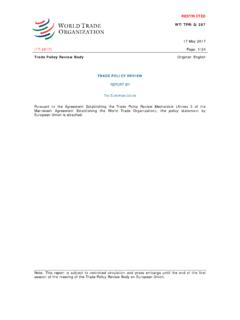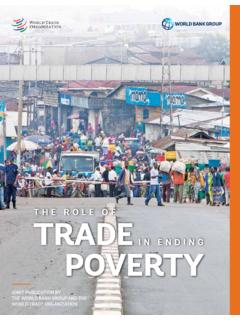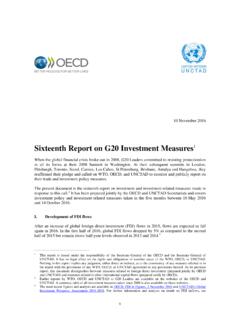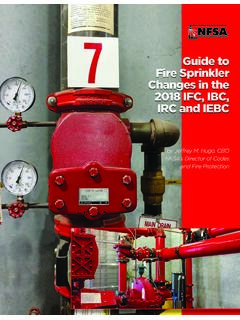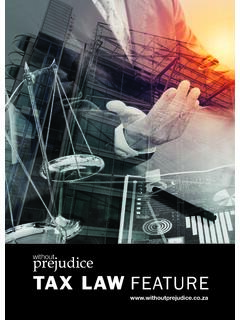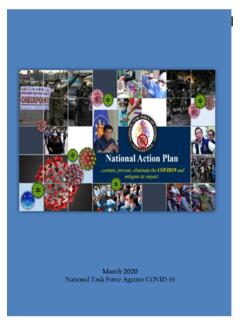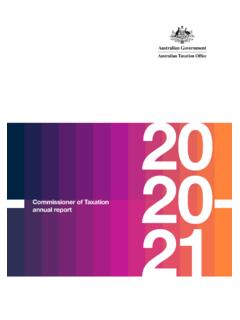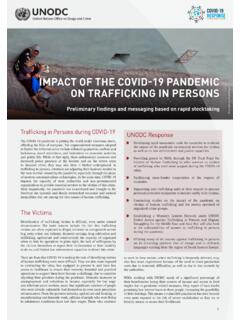Transcription of TRADE COSTS IN THE TIME OF GLOBAL PANDEMIC KEY POINTS
1 12 August 2020 Page: 1/10 Original: English TRADE COSTS IN THE TIME OF GLOBAL PANDEMIC INFORMATION NOTE1 KEY POINTS : Travel restrictions and border closures have been an important part of the initial policy response to the COVID-19 PANDEMIC , and these measures have directly affected TRADE in goods and services. They have disrupted freight transport, business travel and the supply of services that rely on the presence of individuals abroad. Transport and travel COSTS constitute an important part of TRADE COSTS , and, depending on the sector, are estimated to account for 15 to 31 per cent. Travel restrictions are therefore likely to account for a substantial increase in TRADE COSTS for as long as they remain in place. Freight transport service performance is crucial to TRADE COSTS in manufacturing. Since the beginning of the COVID-19 crisis, maritime and land transport have remained largely functional, although they have registered sometimes considerable delays, but air freight transport has been severely disrupted, with GLOBAL air cargo capacity shrinking by per cent in March 2020.
2 Many governments are trying to do as much as possible to keep TRADE flowing, but in some regions, travel restrictions have the potential to disrupt regional TRADE and livelihoods severely. Tradable services that rely on physical proximity between suppliers and consumers, such as tourism, passenger transport or maintenance and repair services, have been severely impacted by travel restrictions and social distancing and have seen a prohibitive increase in TRADE COSTS . The disruption in business travel, which plays important roles in establishing and maintaining trading relationships as well as in managing GLOBAL value chains, is also likely to affect both business and professional services and manufacturing production, although this will depend on how possible it is to substitute e-interactions for face-to-face communication. The quality of information and communications technology (ICT) infrastructure and digital preparedness will thus be important factors in how well economies cope with the PANDEMIC shock.
3 Estimates suggest that TRADE policy barriers and regulatory differences account for at least 10 per cent of TRADE COSTS in all sectors. Products essential in the fight against the PANDEMIC have seen the introduction of mostly temporary import-facilitating and export-restrictive measures. The former push down TRADE COSTS while the latter raise them. Nevertheless, both types of measures have covered a small share of GLOBAL TRADE . High levels of uncertainty magnify the impact of TRADE COSTS on international TRADE . In the first quarter of 2020, for instance, a widely used measure for the GLOBAL level of uncertainty was 60 per cent higher than the levels triggered by the Iraq War and the Severe Acute Respiratory Syndrome (SARS) outbreak in 2003. Uncertainty reduces the appetite of firms to invest into new trading relationships, and the increase in uncertainty may also result in TRADE finance contraction that is likely to take a particularly heavy toll on emerging and developing economies.
4 1. INTRODUCTION Every GLOBAL economic crisis brings about a decline in GLOBAL TRADE . Every crisis, however, is different. While TRADE COSTS , in the form of sweeping protectionism, played a leading role in the sharp contraction in world TRADE during the Great Depression of 1929 and the 1930 s, they played 1 This document has been prepared under the WTO Secretariat's own responsibility and is without prejudice to the positions of WTO members or to their rights and obligations under the WTO. 2 only a small role in the great TRADE collapse of 2009, which was primarily about a steep fall in aggregate Governments around the world have responded to the COVID-19 health crisis by imposing mitigation measures that have paralysed, or at least sharply curtailed, many sectors of the economy. Social distancing, quarantine, lockdowns and travel restrictions have become unavoidable measures in the fight against the PANDEMIC .
5 Even jurisdictions with relatively relaxed official restrictions on social and business activity have seen sharp declines in economic output, as individuals change their behaviour to try not to catch the virus. This note uses insights from an ongoing WTO TRADE COSTS project3 and available real-time indicators to outline how the reactions to the COVID-19 PANDEMIC may affect TRADE COSTS . 2. TRANSPORT AND TRAVEL COSTS Transport and travel COSTS constitute an important part of TRADE costs4 in all sectors (Figure 1). They include transport margins, business travel COSTS and the cost of time in transit. They are estimated to account for 15 per cent of TRADE COSTS in agriculture and 31 per cent in manufacturing TRADE . Transport COSTS also matter for goods-related services, such as retail and wholesale, where the estimates suggest they account for 19 per cent of total TRADE COSTS . Finally, travel COSTS account for almost a third of TRADE COSTS related to cross-border supply in business and professional Figure 1: Determinants of TRADE COSTS Note: This decomposition shows to what extent various factors contribute to explaining the variation in bilateral TRADE COSTS in 2016.
6 See WTO (2019), for details of the data sources and methodology. "Other services" include telecommunications, financial, business, professional, cultural and personal services. Travel restrictions and border closures were an important part of the initial policy response to the PANDEMIC (Figure 2). These measures directly hit TRADE in goods by disrupting cargo transport services as well as TRADE in services in different modes of supply by effectively stopping consumption abroad and limiting the physical presence of suppliers abroad. Moreover, even in 2 See for instance Eichengreen and Irwin (2009) on the role of TRADE policy during the Great Depression and Bems, Johnson and Yi (2013) on the drivers of the TRADE collapse in 2009. 3 The GLOBAL TRADE COSTS Index (WTO, forthcoming). 4 We use a broad definition of TRADE COSTS that includes all factors that depress foreign sales more than domestic sales, such as transportation COSTS , policy barriers, information and transaction COSTS , contract enforcement COSTS and regulatory COSTS .
7 5 We estimate TRADE COSTS in services from data on cross-border supply (mode 1 of the four modes of supply of services defined in the General Agreement on TRADE in Services GATS) and consumption abroad (mode 2 of the GATS). In the case of business and professional services, consumption abroad plays a lesser role (only per cent of total TRADE , as per WTO TISMOS) and hence it can be assumed that most of the estimated TRADE COSTS relate to cross-border TRADE . 15%31%19%27%18%15%20%15%2%3%3%5%10%12%14 %10%7%9%8%7%2%3%3%3%46%27%33%33%0%20%40% 60%80%100%AgricultureManufacturingDistri butionservicesOther servicesTransport and travel costsInformation and transaction costsICT connectednessTrade policy and regulatory differencesGovernance qualityUncertaintyOther3 sectors that do not rely entirely on international travel for their product delivery, these measures have had a negative impact by curbing business trips. Face-to-face interaction is often necessary for establishing business relationships and managing GLOBAL value chains, and it plays a significant role in the production of many services.
8 Travel restrictions are thus likely to account for a substantial increase in TRADE COSTS for this important TRADE component for as long as they remain in place. Figure 2: International travel controls by stringency and date Source: WTO Secretariat's calculations based on Oxford COVID-19 Government Response Tracker (Hale, Webster, Petherick, Phillips and Kira, 2020). Data available for 177 jurisdictions until August 1 and 166 jurisdictions on August 1. Disruptions to freight transport The performance of cargo transport services is crucial to TRADE COSTS in manufacturing. Both prices and the timeliness of transport services enter the TRADE COSTS Since the beginning of the COVID-19 crisis, maritime and land transport have remained largely functional, although they have registered sometimes considerable delays, but air freight transport has been severely Maritime transport must cope with issues related to port logistics.
9 Many economies have changed port protocols, ranging from port closures and crew-change restrictions to additional documentation requirements and physical examinations on vessels and of crew members originating from, or having called at, exposed economies, which disrupt shipping Moreover, to prevent lower demand from depressing shipping rates, the maritime freight transport industry has decreased its supply of sailings. As a result, while the cost of container shipping in January and February was comparable to the same period last year, the rebooting of the Chinese economy started pushing the prices up in mid-March, and the rebound of consumer demand in the United States caused a surge in May (Figure 3). It may take some time before prices return to equilibrium. 6 Hummels and Schaur (2013) estimate that each day in transit is equivalent to an ad valorem tariff of to per cent. 7 For a detailed account of the impact of COVID-19 on transport services, see the WTO information note on TRADE in services in the context of COVID-19.
10 8 See, for instance, Heiland and Ulltveit-Moe (2020). 05010015001 Jan15 Jan01 Feb15 Feb01 Mar15 Mar01 Apr15 Apr01 May15 May01 Jun15 Jun01 Jul15 Jul01 AugNumber of countriesNoneScreeningQuarantineBan from someBan from all4 Figure 3: Shipping rates started climbing in March 2020 and surged in May 2020 Source: International land transport has been affected by border controls, sanitary measures (such as measurement of the temperature of drivers) and special arrangements, such as the closure of certain border posts and detours. The risks associated with travel to affected economies may also have resulted in a lack of drivers. These factors ha ve caused delays in road cargo transport (Figure 4) . To alleviate these issues, some exporters have tried to shift the load from road to rail, as the latter needs far fewer drivers and controls per amount of Figure 4: Waiting times at European border-crossings April 14, 2020 at May 18, 2020 at More than 10km queues More than 1-hour delays More than 30-min and less than 1-hour delays Less than 30-min delays Source: Travel restrictions have hit air transport particularly hard because they have led to a drastic reduction in passenger flights (Figure 5), which account for around half of air cargo volume.




